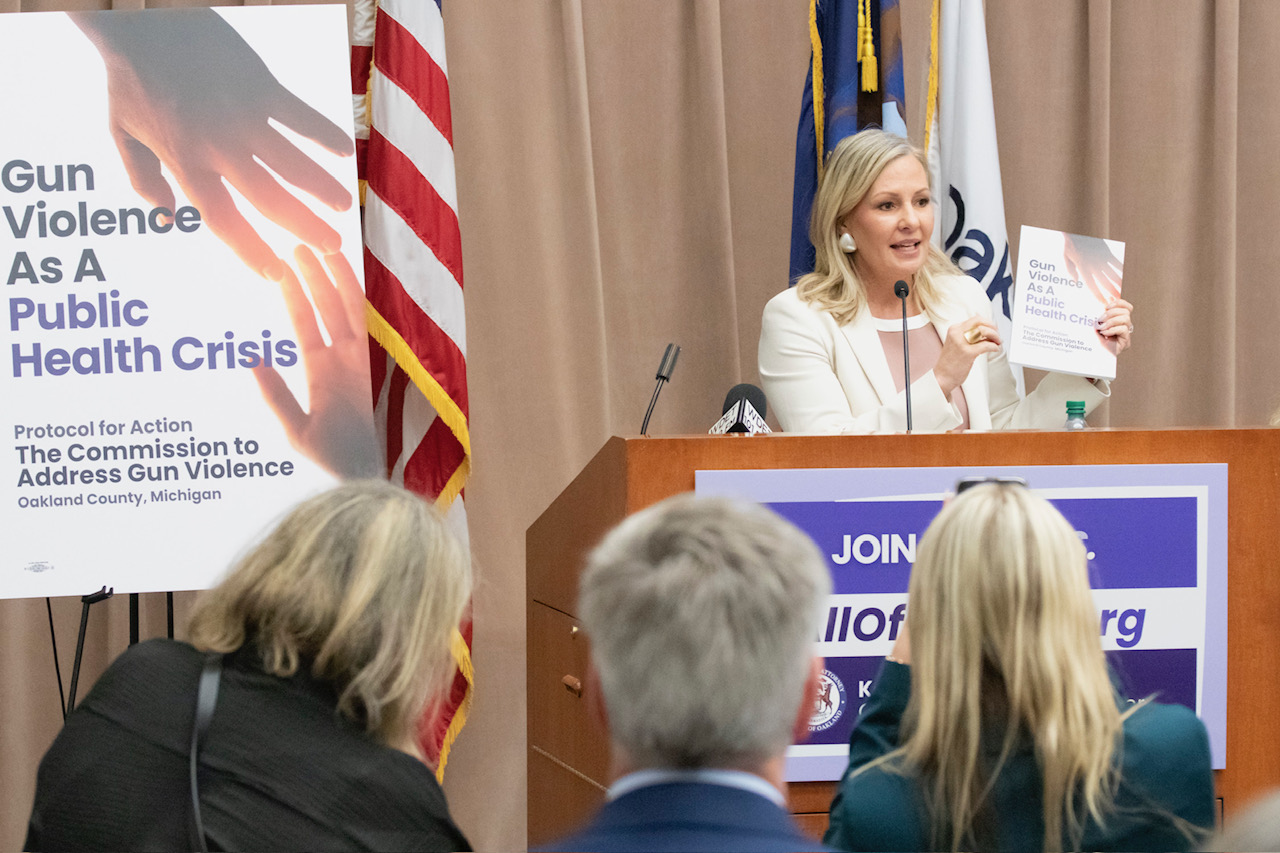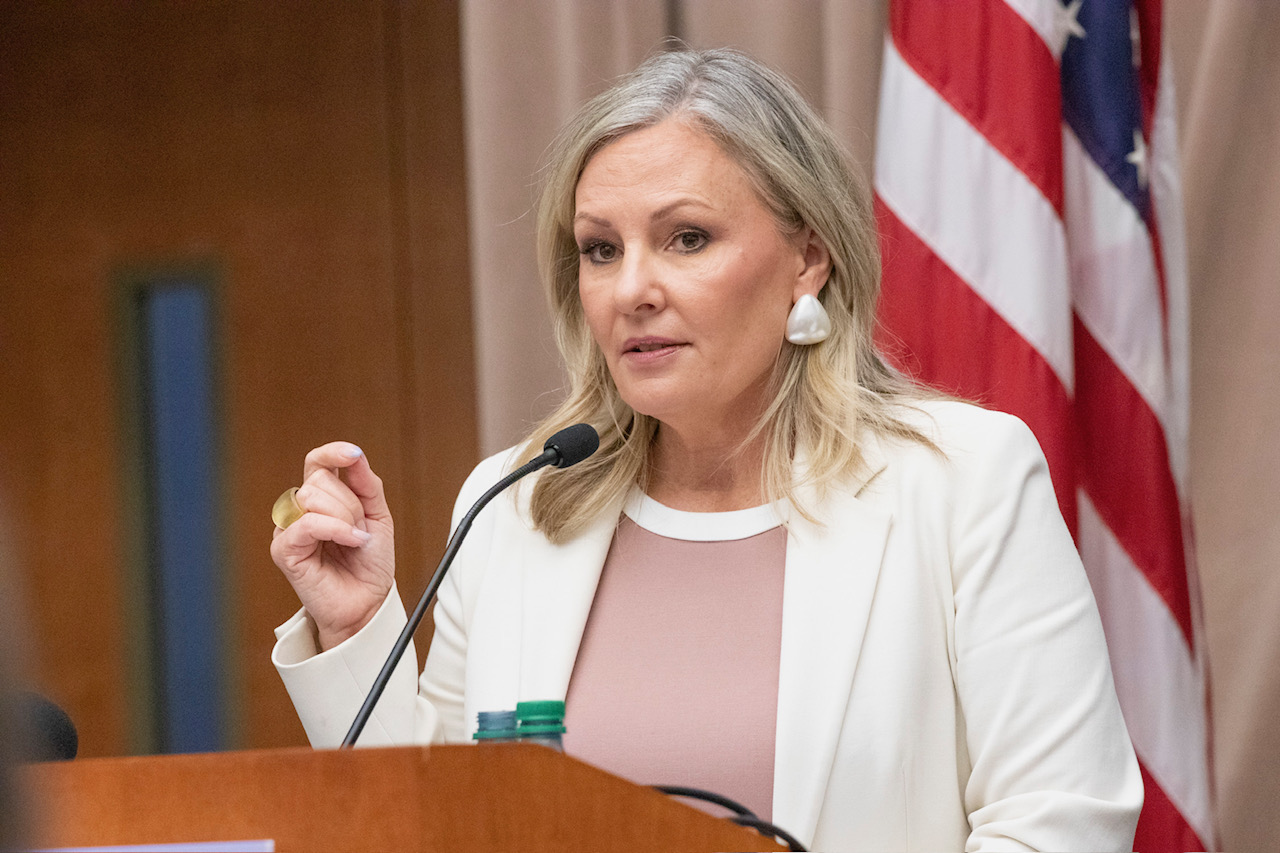America is in Crisis
In 2020, firearm-related injuries surpassed motor vehicle accidents as the leading cause of death among children and adolescents. And now, over 40,000 people are losing their lives each year to gun violence.
On November 30th, 2021, Oakland County joined the growing list of communities across our nation devastated in the wake of a mass shooting. We need new ways to prevent gun violence, as we’re not going to legislate or prosecute our way out of the crisis.
Instead, we need real tools to prevent it, which is why Prosecutor Karen D. McDonald formed the Commission to Address Gun Violence in September 2022. The group was asked to develop an evidence-based approach to combat gun violence in our community and beyond.
The information and best practices contained in this protocol for action are just the start.
Protocol for Action Preface
Karen D. McDonald, Oakland County Prosecutor
In the aftermath of the November 30, 2021 shooting at Oxford High School, where four students were killed and seven others injured, I got questions from mothers, fathers, neighbors, teachers, other elected officials, and people from across our county. They were simple questions:
“My daughter is starting kindergarten in a few months. Should I get her a
bulletproof backpack?”
“How could this happen? How could a fifteen-year-old have access to a gun and use it to shoot and kill his classmates?”
“My kids don’t feel safe. I don’t feel safe. Are we safe?”
A few months later, a 7-year-old girl was killed during a drive-by shooting in Pontiac, as her mother drove her home from school, with her sister and cousins sitting next to her.
I was asked those questions again.
After each shooting, I was asked the same questions. Again, and again, and again.
Two conclusions led me to create this foundation:
- I had the same questions.
- I did not have the answers.
All of Us is a culmination of an unyielding drive to provide some answers.
Formed as a 501(c)(3) organization, All of Us urges communities, caregivers, and policymakers to use the same strategy we’ve successfully used to battle the other top causes of death for kids, like automobile accidents: treat gun violence with a public health approach that begins with education.
We can prevent gun violence, but there is no “one thing.”
Research and experience make it clear that there is no one curriculum, training, assessment, technological innovation, safety system, tactical response, or legislative solution that is going to solve this problem.



Gun violence is the leading cause of death for children and adolescents in the United States. It surpassed fatal car crashes in 2020, and in 2022 alone, over 48,000 people were killed by guns in the United States. It’s a public health crisis. If we take a public health approach to gun violence, as we did with car crashes, we can reduce gun deaths.
At the Oakland County Prosecutor’s Office, we have heard from countless parents and victims of gun violence who are searching for an answer to one simple question: “what can we do?” These recommendations are designed to answer that question in a concrete, understandable way that you can use to reduce gun deaths in homes, businesses, workplaces, places of worship, and across your community.
Gun deaths are largely preventable. There are strategies that we know work, and there are many other promising approaches worth pursuing. But we must recognize that the problem is complex, and there is no one solution.
The first step is to educate ourselves about gun violence and its root causes. One of the things we have learned is that different kinds of gun violence, like suicide, targeted shootings, and intimate-partner violence, all have common root causes. We have also learned that there are often common solutions. For example, there is strong evidence that social-emotional learning, peer-based mentoring programs, and community violence interrupters can be effective in reducing multiple kinds of gun violence.
As we transition from education to action, the “what can I do?” question can be broken into digestible pieces:
- What can we do long before someone engages in gun violence?
- How can we identify someone in crisis?
- What is a threat assessment and when is it appropriate?
- How can we help someone in crisis?
- How can we learn from incidents of gun violence, and how can we support victims and their families?, and
- How can we shape our environment to promote safer communities from gun violence?
To answer those questions, Prosecutor Karen McDonald created the Commission to Address Gun Violence. The Commission drew on expertise from practitioners and researchers across professions, including first responders, faith-based leaders, community-based organizations, public health researchers, educators, and law enforcement professionals. We also worked closely with victims of school shootings and Sandy Hook Promise to incorporate their insights on how to support individuals and communities in the aftermath of a mass shooting. These recommendations are the result of their work.
Programs and strategies identified in these recommendations cover everything from anti-bullying and social emotional wellness at one end, to environmental infrastructure and security (i.e., target hardening) at the other. Between these are a vast number of prevention and intervention strategies that have been implemented in many places in Michigan and across the nation. One important initiative that is growing in prominence is the use of reporting systems. In Michigan, the only state-wide reporting system, OK2SAY, is based with the State Police, and is only used in schools. We discuss the need for a state-wide reporting system that can be used across a spectrum of organizations (including schools, but also employers and employees, faith-based organizations, and government and private-sector entities). As part of that recommendation, we review the strength of evidence across different programs and strategies, and the potential barriers, costs, and considerations for implementation.
The recommendations here can be used anywhere, but they are not one-size-fits-all. Decisions about what approaches to implement in your community need to be informed by, and respond to, the effects of trauma on individuals and communities, especially those that have experienced historical disinvestment, economic decline, and dwindling employment opportunities. Successful implementation will also require a community-wide approach that includes schools, the public and private sector, non-profits, and faith-based organizations.
It is important to note that some of the programs identified here have been subjected to rigorous study, and are proven to work. Others appear promising, but further study is needed. Still others are ideas that are supported by common sense or are logical extensions of what we already know. All of them are worth pursuing as we continue to learn which approaches work best in each community.

